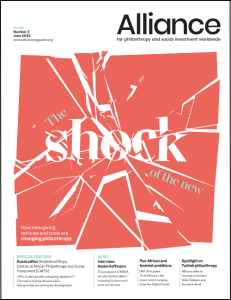The traditional hierarchical structure for philanthropy might mean well – but it’s rooted in patriarchal power and the white supremacy of the ‘white saviour’ who knows best swooping in to tell a community how to spend the donation. The traditional way is also grossly under-serving women and girls, who make up 51 per cent of the population, yet organisations that specifically serve these groups only receive 1.9 per cent of all philanthropic funding.
It’s time for a shift from this top-down, broken model to a more circular, intersectional, and trust-based model – one that was pioneered by women’s funds and foundations. Giving circles are a clear path to upending the current power dynamics that we’ve seen stunt women’s progress time and time again. They address the current imbalance in power structures while innovating ways to get marginalized genders the capital they need to make lasting social change. Giving circles value collaboration and trust between donors and grassroots organisations, especially those led by women of colour, who are on the ground doing the work, to know what’s best for their community.
So what is a giving circle (GC)? It’s a group of people with shared values who come together to collectively discuss and decide where to make a pooled gift. Say, for example, a 50-person GC planned to have each member volunteer for 10 hours, contribute $1,000, and tap 50 people in their networks to grow awareness. By amplifying the impact through a GC, that would lead to 500 total volunteer hours, $50,000 to invest in worthy causes, and a reach of 2,500 diverse people.
GCs were popularized when working women rose in the ranks in record numbers in the 1980s and ‘90s, amassing their own wealth for the first time and deciding to distribute it differently than their husbands or fathers did – collectively, based on relationships and building consensus. In the late ‘90s, Washington Women’s Foundation’s founder Colleen S. Willoughby popularized GCs, which started to take off as ‘the way women give.’ The truth is, GCs had been happening among all genders around the globe for centuries, says Adriana Loson-Ceballos, PhD, an expert on GCs and the co-founder of Colmena Consulting. ‘In my research, I’ve found evidence of giving circles among enslaved groups and different Indigenous cultures–for example, it was common practice in Mexico before Cortés,’ she says. ‘It was popular because in collective giving, the relationships within a community matter. There is dignity in both giving and receiving.’ And because everyone has skin in the game and majority rules, whether you personally like the outcome or not, she says, ‘Collective giving models are laboratories of democracy.’
This philanthropic model is democratic, place-based, highly flexible, community-focused, and participant-led. GCs work because they’re an intersectional approach with fierce urgency to support nonprofit partners as well as the communities hit hardest by the disproportionate impacts of economic hardship, broken social systems, lack of access to health services and information, systemic racism, and institutional violence. GCs uplift gender and racial justice together. GCs share power to share solutions. For these reasons, members in our organisation, among others, have increasingly embraced GCs for the past 20+ years. One estimate puts just 50 GCs in existence in 1995; today, there are 2,500, and by 2025, it’s projected to be up to 3,000.
Geography is historically the most common uniting force in GCs, says Loson-Ceballos, followed by identity; think Black women trying to give to Black women and girls or Asian women funding anti-Asian-hate work, who have seen firsthand that their group’s issues haven’t been funded. Research has shown that something very cool happens: the longer you are part of a giving circle, the more likely you are to give in ‘cross solidarity’ – ie, Black women starting to also give to causes benefitting Asian women. That’s because the more we look at our own community’s issues, the more we realize how interconnected our liberations truly are.
One example of an early adopter of GCs was the Chicago Foundation for Women (CFW), which launched its first GC, the LBTQ Giving Council, back in 1998, because the LGBTQIA+ community wasn’t seeing their interests represented or centred. Since then, CFW has steadily expanded their GCs, adding four based on geographic areas of the city and two more based on communities, one for Women of Color and another for Young Women. Today nearly 200 members are part of GCs, pooling their resources and awarding anywhere from $20,000 to $526,000 directly to local nonprofits. ‘It’s an effective way to amplify the voices of underrepresented women as philanthropists,’ says Felicia Davis Blakley, CFW President & CEO. ‘Giving circles link grassroots organisations to funding, but it’s not just a one-way benefit; our connection also helps our Foundation keep learning about new issues, models, leaders, and ideas.’
How Women Lead is a network of top women executives in the Bay Area that also believes in the dual benefits of giving and receiving through GCs. The 50 members have awarded nearly $500,000 in grants to direct services for women and girls over the last five years as well as joined boards and connected the groups with their own networks. ‘Our members want to have big impacts and to work with the grassroots groups that don’t have the advertising budget or long national history to be household names. We’d rather support fledgling neighbourhood organisations that are specifically helping women, but busy members often don’t know how to find and connect with them,’ says Julie Castro Abrams, CEO of How Women Lead. For example, around seven years ago, the group’s GC awarded a $10,000 grant to AnnieCannons, a program that helps survivors of human trafficking train for careers in software development, offering mentorship, job training, and support in negotiating for fair pay. At the time, it was the first major grant the organisation had received; now they’re fully self-sufficient, with hiring partner contracts from tech companies more than covering the program’s operating costs.
The #MeToo movement gave culture the important phrase ‘Believe women,’ and it can also be a rallying cry for believing that women know the best way to fund solutions for ourselves and our communities. GCs are part of the DNA of women’s funds, and despite the exponential growth in their popularity, are still mostly populated by women; in fact, 70 per cent of GCs are majority women, according to data from the Women’s Philanthropy Institute. Philanthropy can reach its full power and potential through believing women and adopting this powerfully feminist way of moving money. GCs also amplify the voices of underrepresented women in philanthropy, trusting women with lived experience, especially women of colour, as experts who don’t need to ‘justify’ their choices to a paternalistic overseer.
GCs are an opportunity to bring fresh ideas, unique concerns and perspectives, and new energy to philanthropic leadership and advocacy. As more funders in the philanthropic world learn about the benefits of the GC model and adopt it, we can harness the power of women’s innovation and share power collectively.
Elizabeth Barajas-Román is the President & CEO of the Women’s Funding Network, the largest network in the world for gender equity.
Upcoming issue: New giving vehicles and tools
 New giving vehicles and tools have proliferated in recent years with the conventional foundation model supplemented by donor advised funds, limited liability companies and personalised giving services. At the same time, technology is providing more direct means of fundraising and bringing in new people as donors. What are the implications of these changes? Is the conventional foundation model at risk of being supplanted? And are new means of individual giving producing greater democracy? This special feature explores the implications for institutional philanthropy.
New giving vehicles and tools have proliferated in recent years with the conventional foundation model supplemented by donor advised funds, limited liability companies and personalised giving services. At the same time, technology is providing more direct means of fundraising and bringing in new people as donors. What are the implications of these changes? Is the conventional foundation model at risk of being supplanted? And are new means of individual giving producing greater democracy? This special feature explores the implications for institutional philanthropy.
Subscribe today so you don’t miss it! Or you can pre-order the single issue here with a 20% discount.



Comments (0)